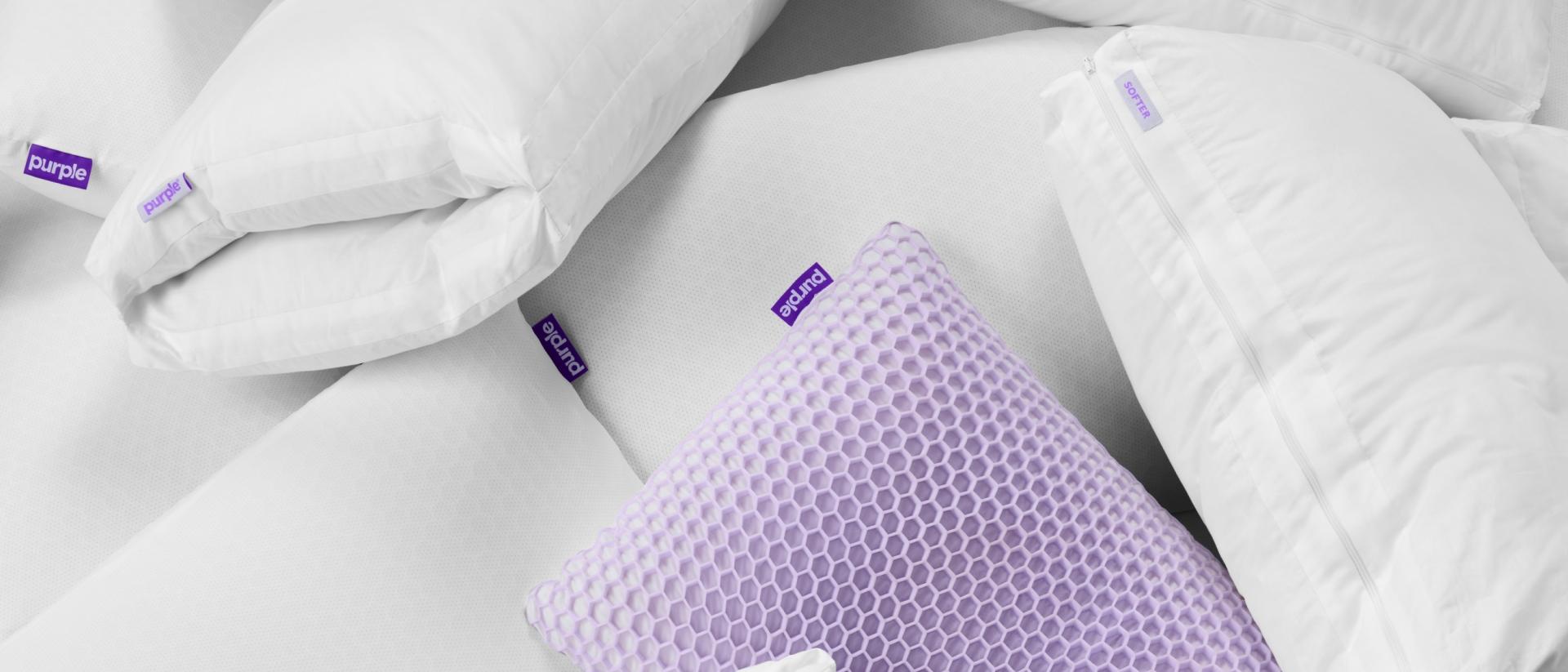
12 Different Types of Pillow Stuffing: Which Is Best For You?
Picking the right pillow can impact your support and comfort while sleeping, but it can be tough to choose due to the vast array of pillow types. One factor that affects a pillow’s comfort is its stuffing. The pillow stuffing that some find comfortable may be too stiff and heavy for others.
Narrow down your pillow stuffing choices by taking contouring, breathability, and shape retention into consideration. Learn more about types of pillow fillings and their pros and cons, so you can choose the best one for your sleeping needs and preferences.
If you suspect that the wrong pillow filling is causing your sleepless nights, compare Purple's pillow selection to find one that best enhances your sleep through innovative technology. For more tips on which considerations affect pillow comfort, check out our guide to how to pick the best pillow.
12 Popular Types Of Pillow Stuffing
Pillow stuffing directly impacts its comfort. Materials can change a pillow’s overall airflow, firmness levels, and shape retention.
Below we’ve detailed the 12 most popular types of pillow stuffing and their pros and cons, so you can choose the best pillow fill types for you:
1. GelFlex® Grid
Purple’s comfortable pillows feature our proprietary GelFlex® Grid is an injection-molded, hyperelastic polymer. Squishy and stretchy, this material is constructed in a lattice formation to promote airflow and deliver better pressure relief.
With the application of weight, the Grid instantly adapts to shape, flexing, and adjusting underneath concentrated weight, such as where your head and shoulders meet the pillow's surface. When the weight is removed, the Grid rapidly returns to its original shape.
Pros
- The GelFlex® Grid is supportive yet soft, designed to cradle your head and neck while you sleep.
- It has over a thousand built-in air channels that promote air flow and dissipate heat keeping you cool at night.
Cons
- The material tends to weigh more than other pillow options.
The classic Purple pillow is made to adapt to shifting sleeping positions. Because its GelFlex® Grid material is breathable and responsive, it relieves pressure and is an ergonomic pillow option for those looking for neck support.
2. Talalay Latex Stuffing
Talalay latex is a natural type of latex that’s less dense than Dunlop latex. Because of its more intensive processing, Talalay latex is softer, fluffier, and generally more breathable. Its softness also makes it a common addition to comfort layers, allowing various sleepers to comfortably sink into its cloud-like cushioning.
Pros
- It’s known for its gentle pressure relief, contouring around your neck and head for extra support while sleeping.
- Talalay latex is highly breathable, which may offer people who get hot at night some relief from sweaty, sleepless nights.
Cons
- Latex typically has a noticeable, yet mild smell that is generally specific to traditional latex pillows.
The Purple Harmony™ pillow combines a honeycomb GelFlex® Grid layer with the plush softness of Talalay latex, creating a cradling surface that supports shifting sleeping positions. Because both the GelFlex® Grid and Talalay latex are highly breathable, cushioning, and pressure relieving, this Talalay latex pillow offers a harmonious blend of comfort and support, making it one of the best pillows for side sleepers and combination sleepers.
3. Down Alternative Stuffing
This pillow stuffing is made with synthetic down, which typically consists of polyester microfiber fill. Unlike less expensive poly-fil, down alternatives are designed to give the same soft, fluffy feeling of down feathers.
Pros
- Down alternative simulates the cuddly, cloud-like feeling of down stuffing at a lower cost.
- It’s typically machine-washable, making it easier to clean and maintain.
Cons
- It may feel a little heavier and denser to some sleepers.
- It may develop lumps with regular use.
If you love the idea of a soft, down-alternative pillow with gentle cradling, the Purple Grid Cloud™ Pillow is a perfect choice. This pillow pairs ultra-soft, down-like fill with a layer of Purple’s flexible GelFlex® Grid, delivering plush comfort while maintaining responsive support.
Its breathable design helps keep you cool throughout the night, and the medium loft makes it ideal for back and combination sleepers who want a balance of softness and support in their pillow.
4. Cotton Pillow Stuffing
Cotton stuffing is one of the most widely used and widely available pillow stuffings. 100% cotton is soft, breathable, and naturally hypoallergenic, helping sensitive sleepers and hot sleepers snooze soundly.
Pros
- Cotton is naturally breathable and moisture-wicking.
- Because it’s naturally hypoallergenic, it’s less likely to trigger allergic reactions in sensitive sleepers.
Cons
- It’s prone to clumping over time.
- Cotton filling needs to be replaced more frequently than other pillow stuffing types.
5. Wool Pillow Stuffing
Wool pillow stuffing is made from sheep fleece. This pillow stuffing is warm but breathable because the cells on the outer fibers of wool stuffing are very porous. This allows them to rapidly absorb and evaporate water.
Pros
- Wool is mold and mildew-resistant, making it easier to maintain and a solid pillow option for sensitive sleepers.
- It’s soft and fluffy while wicking moisture, preventing that clammy feeling that some people get from sleeping on insulating pillows.
Cons
- It’s prone to lumping, which may feel uncomfortable over time.
- While its warmth makes it a great insulating pillow, hot sleepers may prefer a more cooling pillow stuffing.
6. Microbead Pillow Stuffing
This pillow stuffing consists of small polystyrene beads and is designed to be a synthetic alternative to buckwheat hulls. Its unique composition and structure allow air to readily pass through it, but these properties also make it prone to lumping.
Pros
- It’s highly breathable.
- It’s very moldable, quickly adapting to your body’s weight and pressure points.
Cons
- It’s not widely available in the market.
- They can produce “off-gassing” and chemical odors which some sleepers may find unpleasant.
7. Kapok Pillow Stuffing
Kapok stuffing is made from the cotton-like flowers of a Mexican tree. Eco-friendly and free of toxic compounds, kapok is a soft stuffing choice that environment-conscious consumers may want to try.
Pros
- It’s 100% organic and natural, which may help sleepers who have allergies or are sensitive to smells.
- It’s very lightweight yet soft and snuggly.
Cons
- It’s highly flammable.
- It’s not widely available.
8. Memory Foam Pillow Stuffing
Traditional memory foam filling is primarily composed of polyurethane foam combined with other substances for a plush, cushioned pillow filling.
Memory foam pillow stuffing can come in two forms: shredded foam and solid block foam. The former is used to stuff a pillow, while a solid memory foam block is simply wrapped in a pillowcase.
Pros
- Memory foam is less prone to clumping, allowing it to keep its shape and height well.
- It contours around high-tension areas like the neck and shoulders to alleviate pressure gently.
Cons
- Traditional memory foam is prone to trapping heat, which hot sleepers and stomach sleepers may find uncomfortable.
- Some types of memory foam have volatile chemicals that may smell a little strange while sleeping.
9. Feather Pillow Stuffing
Some pillows are stuffed with feathers taken from the backs and wings of birds, usually geese or ducks. For additional softness, these feathers are sometimes combined with bird down, which is the soft layer of feathers closest to birds' skin.
Learn more about the difference between this material and down stuffing in our down pillows vs. feather pillow comparison guide.
Pros
- Feather is one of the most affordable pillow stuffing options on the market.
- It is very lightweight and moldable, readily cushioning pressure points as your weight sinks into it.
Cons
- It loses its shape and flattens from regular use, so feather-filled pillows need to be fluffed regularly.
- Feather-filled pillows are hard to clean and can smell “off” after a few years of continued use.
10. Polyester Fiberfill Pillow Stuffing
Also known as polyfill, polyester fiberfill stuffing is made of small synthetic polyester fibers. This man-made pillow stuffing is affordable, fluffy, and easy to maintain, but it’s also not very durable.
Pros
- Polyester is machine-washable, making it very easy to maintain and clean regularly.
- It’s more affordable than animal-sourced stuffing types like down but still fluffy and soft.
Cons
- It loses its shape easily.
- It’s less durable and prone to clumping.
11. Down Pillow Stuffing
Down pillows are traditionally stuffed with at least 75% down and no more than 25% feather filling. Made from the softest, quill-free feathers of geese and ducks, down pillows are some of the most luxurious and expensive pillows you can find on the market.
Pros
- Down is less prone to trapping body heat, so sleepers can enjoy a cool night’s sleep with a down-stuffed pillow.
- It’s lightweight and has a soft, very cuddly feeling that improves overall comfort.
Cons
- Some sleepers may be allergic to down.
- It may be too soft to support certain sleepers’ heads and necks, especially those who prefer a firmer pillow.
- It needs to be fluffed regularly.
12. Latex Pillow Stuffing
Latex is a natural foam sourced from rubber tree sap. Like memory foam, latex foam stuffing comes in shredded and block forms. It can be difficult to extract, which makes it a pricier but more eco-friendly option compared to other pillow stuffing choices.
Pros
- Latex’s natural open-cell structure makes it very breathable and cooling.
- This bouncy material is naturally mold and mildew-resistant.
Cons
- Natural latex is on the pricier side of stuffing options.
- Though it doesn’t produce off-gassing, it releases an initial smell that some sleepers may feel is off-putting.
Key Takeaways
The material used as stuffing for pillows can affect its height, shape retention, breathability, durability, and overall comfort for different sleepers, depending on how you prefer to sleep on your pillows. What one sleeper finds cozy may lead to uncomfy nights of tossing and turning for others, so consider your unique sleeping needs and preferences before choosing a pillow.
Keep the pros and cons we’ve listed in mind to narrow down your pillow filler choices. If your current pillow doesn’t feel comfortable and supportive, use our guide to help you find a cozy, compatible replacement for your bedroom today!
Apart from pillow stuffing, it’s important to consider which pillow size is best for your sleeping needs, such as your sleep position and personal comfort preferences.
Pillow Filling FAQs
What is the cheapest way to fill a pillow?
Some of the cheapest ways to fill a pillow include using a polyester filling or using a down alternative. These pillow fillers are generally more affordable than the other materials.
Different pillow types can be stuffed with a wide range of materials, and their shape, size, and filler combination can affect how comfortable you find them. Learn more about which may be best for you by reading our guide to pillow types.
